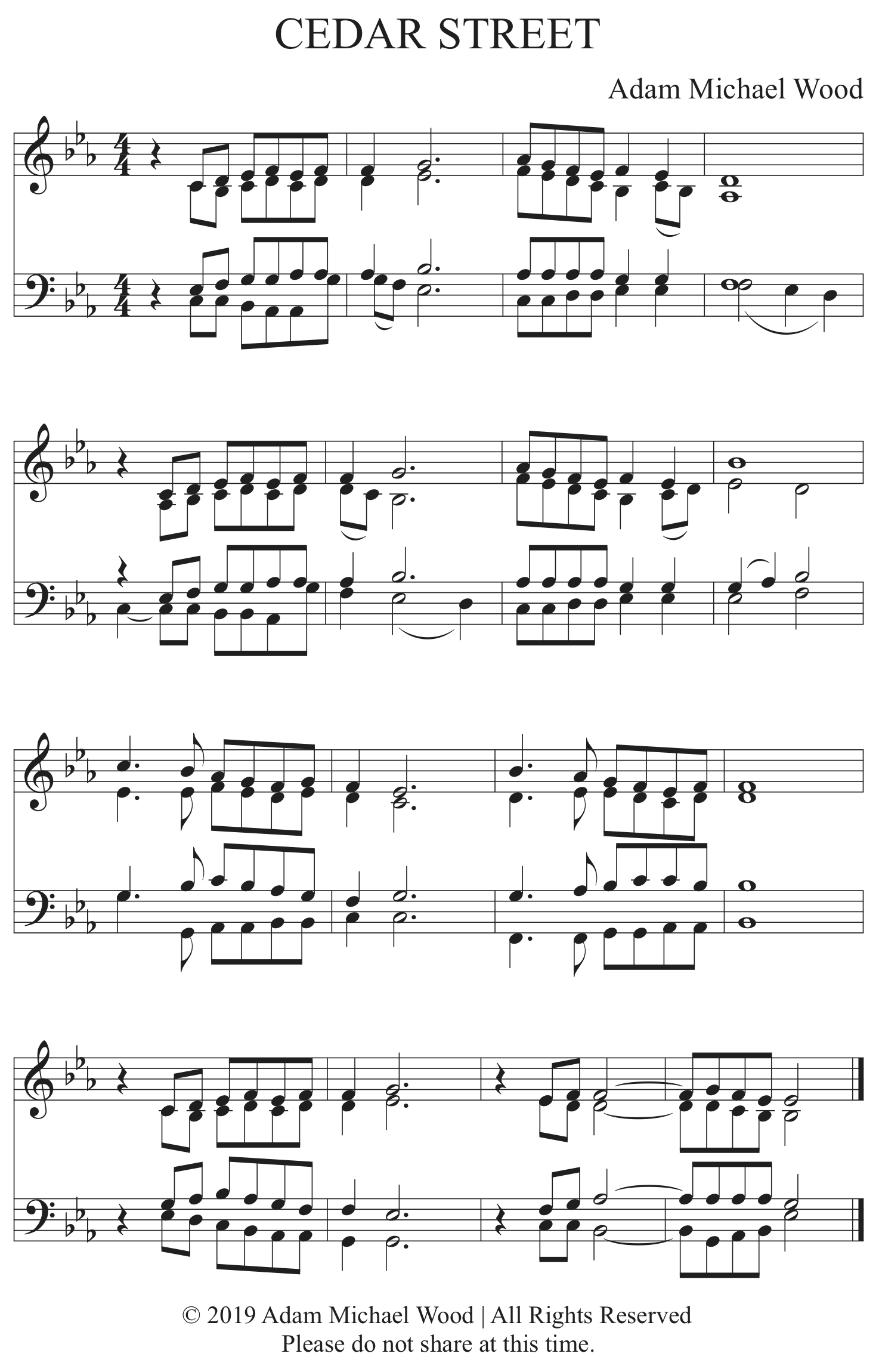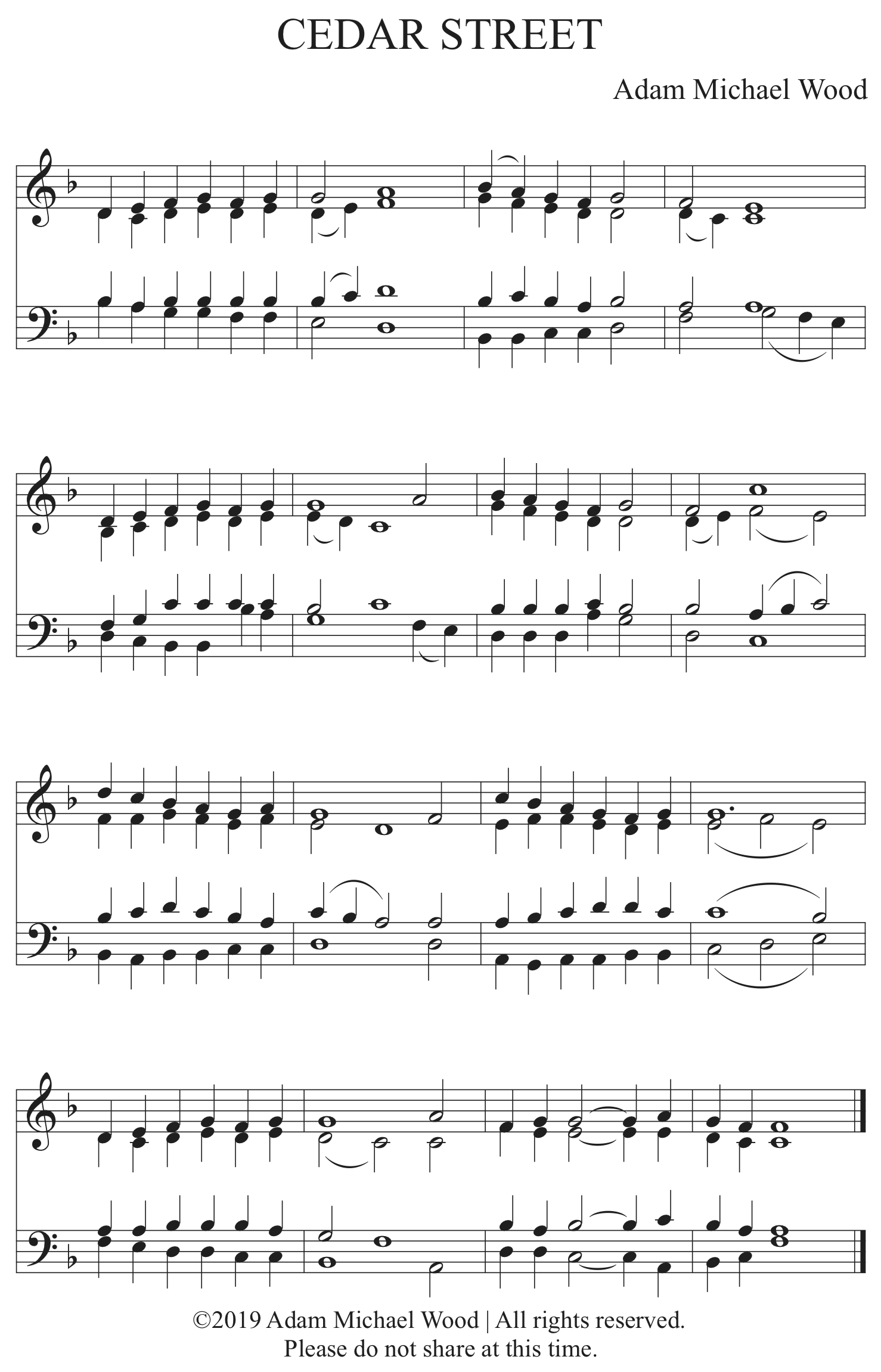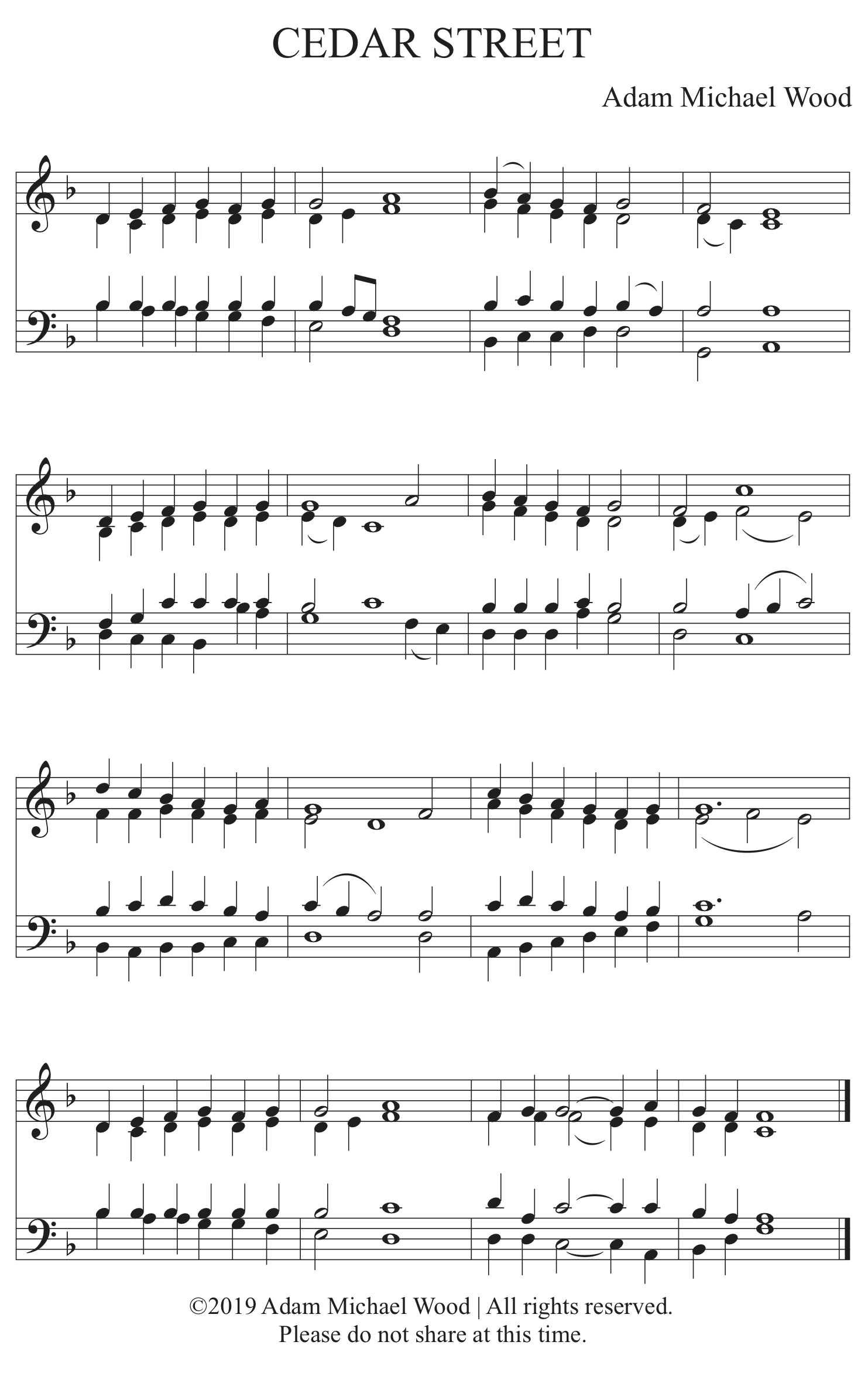New hymn tune - critique/help requested
-
I'm happy with the tune, but I find part writing quite difficult.
Any commentary is much appreciated.

 cedar-street-tune.pdf37K
cedar-street-tune.pdf37K
 cedar-street-tune.png1474 x 2300 - 298K
cedar-street-tune.png1474 x 2300 - 298K -
Curious tune.
Very nice!
(Whence Cedar Street?)Thanked by 1JonathanLC -
(Ha! I suspected something like that.)
Have you a text in mind for this 87 87 87 87 tune? -
Adam,
Welcome back to the forum. (I have the feeling that you've been elsewhere rather than on this forum, but still at CMAA).
Do you intend the parts to be sung, or played instrumentally?
-
It looks fine to me, but there again, I am no composer :) I really like the tune - I am eager to see what others have to say!
-
I like the tune--just hummed it.
I haven't played through it yet, but just looking at it, I'm immediately drawn (not in a good way) to the ascent of a major seventh into a minor second in bars 1 & 5 of the Bass. I could over-look that if it was intended as a purely instrumental line (i.e., if the Tune was to be unison only with accompaniment, a la SALVE FESTA DIES), but for singers, especially more amateur singers in a church choir, it should be avoided.
On a slightly different subject: Personally I prefer a more open notation for hymns: Having so many eighth-note beams/flags on a closed score plus a text between them, ends up looking really cluttered and unappealing; I would suggest a switch from a Common Time notation to Alla Breve. But that's your call. -
I love the tune. Looking forward to knowing the text to which it will be wed. Please keep us updated.Thanked by 1Adam Wood
-
I like the hymn, and would probably like it even better with the text. The melody strikes me as a bit "cramped" in its range and rhythmic patterns, though it does open up a little in the third line (and the poor altos are pretty much stuck between C and E-flat most of the time). Again, this may "work" with the text you have in mind, I don't know.
Having said this, overall I think the harmonization works well. You have established a good "sound" and there is some interesting interaction among the voices, particularly the melody and bass, which is always a good sign. A few things stuck out for me:
(1) In measures 7-8, I think it would be more effective to have the E-flat only at m. 8 (in other words, don't anticipate the E-flat on the third beat of m. 7). Perhaps a chord with a D-flat in it at m. 7. Similar critique at m. 3-4, though the anticipated E-flat is as not troublesome there, in my opinion. However, the parallel 9ths between the bass and soprano (beats 2 to 3 of mm. 3 and 7) seem out of place here.
(2) The first chord of m. 11 also doesn't "work" for me. The F in the bass is good - echoing the G two measures before), but the chord to my ears is not in the same "sound world" as the rest of the hymn. Perhaps change the tenor to A-flat and the alto to D-flat (i.e. bass to soprano: F - A-flat - D-flat - B-flat), and then a B-flat minor chord at the last measure of the line, modifying the harmony in between accordingly. (I happen to like forays into the "flat" side of the circle of fifths within a piece, though this may not be to everyone's taste.)
(3) The "dominant 7th" chord in the penultimate measure sounds (to may ears at least) too conventional an approach to the final chord (V7-I). Similarly for the chords at mm. 4 (good ol' half diminished 7th) and the last measure of the third line.
Finally, I understand you are not writing in common-practice style, but I see some (accidental) parallel 5ths and a parallel octave. I think they are weak part-writing (lack of independence in the voices) if they happen to show up in the texture, and are not done for deliberate effect (as are your parallel 7ths, unprepared dissonances, and other common-practice "no-no's"). -
rich_enough Thank you, this is the level of part-writing feedback I was hoping for.
> Salieri:
> I would suggest a switch from a Common Time notation to Alla Breve.
Yes, someone else has suggested this too. Apparently this notation gives the impression the piece is too fast. I intend it about quarter note = 75-80 as currently written, but the beams make it look like swift runs.
Thank you to every one else as well - you are all most kind. -
I can't play this (not being a keyboard player), but some thoughts:
1. Is the text trochaic?
2. Given the thick texture of close harmonies, parallel intervals in places from syllable to syllable, and what I might find to be a relatively disguised approach to harmonic motion, consider how that may act to obscure the clarity of diction in the chosen text and how well that text is suited to that vocal context.
3. The bass jump of the major seventh to a minor second will invite pitch problems at best - most amateur singers will want (subconsciously) to aim for no higher than F, and flatter downhill from there (as always). Normally, such adventures when ventured are more likely to be kept to inner parts.... (A pure singer perspective that keyboardists may miss....)
4. I'd feel a yearning to stray further from the relatively strict rhythmic motifs. For example, making the second measure of the third line equal notes (but this is merely abstract without the text). A1/A2 // A1/A2 // B1/B2 // A1/C -
> the ascent of a major seventh into a minor second in bars
That is intended as an octave displacement of a descending line. (I originally wrote a straight descent, but it got too low for congregational use, I thought). When I think of the line melodically, I find it relatively easy to sing. -
Also - are the breaks at the half line too long?
I think I want the melody to be more free to alternate between 2s and 3s (CHANT!) but when i write like that, Mainline organists get very confused.Thanked by 1cesarfranck -
Would the E be too high for a congregation?
Adam,
It partly depends on what you think about other music which already does this.
1) The tune Blenheim does this, and the Welsh seem to have no difficulty singing it. (Clearly it can be done...)
2) Sr. Suzanne Toolan's I am the bread of life does it, unless you pitch it in A-flat. (...but maybe it shouldn't be)
3) Among those of us who sing chanted Salve Regina or sequences galore, high pitches are merely par for the course.
-
Hi, Adam!
In general, I think the tessitura of the piece is on the low side for all the parts, which can make tuning difficult.
M.5 resembles m.1 so much that the difference in the bass line is going to look like a discrepancy (Bb-Ab-Ab is changed to Bb-Bb-Ab). Intended?
m.1-2 has a lot of dissonance for so early in the piece: the insistent F-G-Ab combinations make it hard for a listener to grasp the tonality.
m. 11 starts with the 7th of the chord in the bass, which poses a challenge for them and the other parts.
The static chord in m. 12 brings the piece to a stop, and may make it difficult for singers to keep time for the entrance in m. 13.
Hope this helps! -
Just played through. Nice harmony. I echo what The Richards say about mm. 11-12. I like Richard mix's solution F-Ab-Db-Bb, and bar 12 just needs something: it can be difficult in a tune like this to keep the momentum when phrases end on whole-bars, and you've done that well in mm. 4 & 8, but at 12 it just grinds to a halt and sits there. I would do something (unless there's something in the text that would warrant the stasis in that bar).Thanked by 1CHGiffen
-
My thought on bar 12 was a big cadence on the dominant of the relative major, to set up the end. It was harmonically motivated rather than textually motivated, so I'm quite open to adjustment if there's a better way to prepare the last line.Thanked by 1cesarfranck
-
Adam,
3rd system. Both dotted crotchets sound clunky to my ear. The first chord makes sense as an A-flat major one (so, raise the bass pitch from g to a-flat) and the same place two bars later as a b-flat 4-3, (so, raise the tenor pitch to a-flat). -
Any thoughts about transposing up (to D or E minor) to give a little more space for the inner voices? Would the E be too high for a congregation?
I would transpose up a second (d min.) for range--although I like the sound of c minor. The E might be too high for some in the congregation at a morning service.Also - are the breaks at the half line too long?
I think they work, assuming that the text is such that a breath at the half-line is possible without destroying the textual line. I like the movement in m. 6--maybe do something similar in the next line?putting Eb in the bass to double the third
Just don't let a certain uber-Catholic-hymnal editor see it! ;) -
what about putting Eb in the bass to double the third and make the more conventional I6 rather than I64?
Do you mean the first time, to swap the E-flat and the G? -
With a lot of help from others, here is a revised version of this hymn tune.
Thoughts?

 cedar-street.pdf35K
cedar-street.pdf35K
 cedar-street.png1478 x 2302 - 276K
cedar-street.png1478 x 2302 - 276K -
There is the issue, in the (much better) revised version, of parallel fifths and parallel octaves (if indeed these matter, although in general they tend weaken the texture): 5ths S/T in m1, 5ths S/T in m2, 8ves S/B in m1, 5ths A/T in m11, 5ths S/T in m13, 5ths A/T in m13-14 & m15.
The only (I think) instance of parallel dissonance is the parallel 9ths A/B in m13.
In m5, I wonder if the octave leap on B-flat in the bass might be better placed a beat earlier (on beat 4) and the following B-flat (on beat 5) lowered to A.
-
Salieri is right. This melody has that unique quality of strong hymns in that it seems instantly familiar on first hearing and first playing.
-The parallel 5ths in measure 13-15 in the A/T stick out to me, and not in a pleasing way. It is especially apparent in m.14, I think because my ear is expecting the same moving quarter notes that appear in the texture of the parallel sections in mm.2, 6, and 10. A possible fix is to have the alto sing E-D-C, quarter-quarter-whole. On the other hand, I personally favor keeping the alto on D for beats 1-4, but the lush ii7 chord that results might be out of keeping with the ethos of the music...
-The other moment that sticks out to me is the V7 chord in the penultimate measure b3-5. There is melodic development here--it differs from the 4 quarter rhythmic motif of mm. 3, 7, and 11--and I think that the moment would come off stronger without an unstable 7th chord. Besides that, the seventh is held for an extended 3 beats and then fails to resolve to an A, further weakening it. Maybe there is some way to get a 4-3 suspension over the bass C?
-I think a VI-I cadence would sound better than I(64)-I in the last measure.
Thanked by 1Adam Wood -
More corrections and edits.
Thank you to those who have commented, I've incorporated many of your suggestions.
I *think* I've eliminated all the parallel 5ths and 8ves.
(Though it is possible I have introduced additional ones.)
Let me know your thoughts.

 cedar-street.png1483 x 2350 - 270K
cedar-street.png1483 x 2350 - 270K
 cedar-street.pdf34K
cedar-street.pdf34K -
Still has a few parallel 8ves, TB mm3 b1; between mm8-9
-
It's not that I don't know how to find them. It's that I can't pay attention long enough.
Welcome to the MusicaSacra Forum!
To participate in the discussions on Catholic church music, sign in or register as a forum member, The forum is a project of the Church Music Association of America.
Categories
- All Discussions21,106
- General Music Discussion8,218
- Job Openings197
- Management of Music Programs850
- Choral Matters533
- Church Documents and Rubrics524
- CMAA Notes302
- Events716
- For Newcomers: Read First26
- Sacred Polyphony546
- Hymnody872
- Gregorian Chant: General2,697
- ↳ Graduale Romanum and Liber Usualis368
- ↳ Graduale Simplex60
- ↳ Semiology63
- Vernacular Plainsong696
- Anglican Use and Anglican Chant68
- Organ, Other Instruments and Repertoire435
- New Composition/Works in Progress1,291
- Recordings230
- Music for Hispanic Ministry159
- Music Education: Children211
- Music Education: General222
- News Items245
- Positions Wanted2
- General Discussion: Catholicism739
- Amusements177
- General Discussion1,033
- Opinions117






